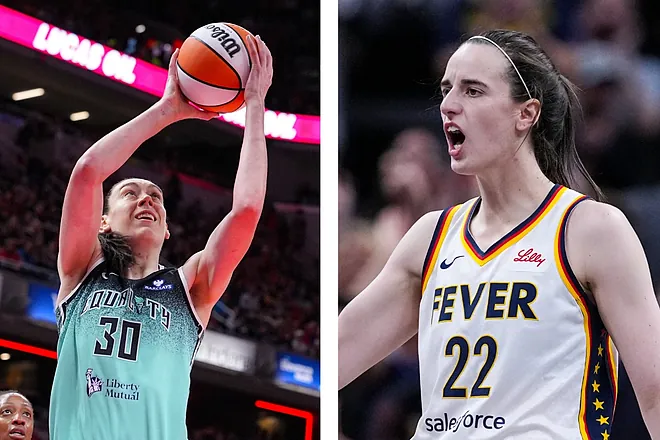The moment was brief but the fallout was seismic. During a tightly contested WNBA game, Indiana Fever rookie Caitlin Clark, one of the most highly anticipated newcomers in league history, was hit with a technical foul that left fans stunned, analysts buzzing, and the broader basketball world embroiled in debate. What began as a split-second whistle has now evolved into a heated national conversation about how officials are policing the game, what standards are being applied to young stars, and whether the WNBA is fully prepared to embrace a player of Clark’s stature and style without undermining her impact through questionable officiating.
The technical foul came in the second quarter of the Fever’s matchup against the Chicago Sky. Clark, who had been vocal but not demonstrative, appeared to say something after a no-call on a drive to the basket. The official promptly issued a technical, sending shockwaves through the arena and raising immediate questions about the threshold for penalizing players, especially in a league striving for more visibility, fan engagement, and momentum. In Clark’s case, her presence alone has drawn unprecedented media attention, increased ticket sales, and record-breaking viewership for both the WNBA and the Fever. Yet her treatment on the court has not always reflected the reverence and protection often extended to other generational stars in their respective leagues.
Clark, known for her fiery competitive edge and expressive nature on the court, has walked a tightrope since entering the WNBA. While she brings unmatched credentials—a historic collegiate scoring record, Final Four appearances, and one of the most electric games in women’s basketball—she also plays with emotion and confidence, qualities that have made her a lightning rod for criticism and controversy. Some believe officials are too quick to police her reactions, while others argue that rookies, regardless of fame, must earn their stripes and accept the same enforcement as anyone else.
But Clark is not just any rookie. She is the face of a new era. Her games are routinely broadcast to national audiences. She’s selling out arenas in cities that hadn’t seen capacity crowds for years. The Fever, once struggling to remain relevant, are now the most talked-about team in the league. Every moment Clark is on the floor is magnified, and every call against her is scrutinized under the glare of a media spotlight rarely aimed this brightly at women’s professional basketball.
That spotlight has made the technical foul more than just a single call. It has sparked larger questions about the WNBA’s ability to adapt to newfound visibility. When a league becomes more popular, the margin for error by its officials becomes smaller. Audiences demand consistency, transparency, and accountability. And when calls appear questionable—especially against players who drive ratings and expand the league’s reach—the fallout can be damaging not just for that player, but for the sport’s credibility.
Some current and former players have come to Clark’s defense, noting the imbalance in how emotion is policed across the league. A few pointed out that veteran stars are allowed to bark at refs, swing their arms, or express frustration without repercussions, while Clark has drawn whistles for less. Others see the treatment as a hazing process, a rite of passage for young players to prove they can handle the league’s physical and mental grind. Either way, it’s become increasingly clear that Clark’s every move is under a microscope, and the officials’ decisions carry heavier weight because of it.
The debate has also extended to fans and commentators, many of whom feel the call was excessive. Social media exploded with slow-motion replays, amateur lip-readers, and calls for greater officiating consistency. Was it a warning-worthy offense or a knee-jerk reaction by an official unable to handle the emotion of a star-in-the-making? The verdict varies depending on who you ask, but what remains clear is the league’s handling of these moments will shape its trajectory as much as the players themselves.
Adding to the complexity is the fact that Clark hasn’t publicly lashed out. She’s remained composed in interviews, often praising her teammates and focusing on team goals over personal slights. But behind her silence is a fanbase that feels protective, frustrated, and increasingly vocal. Supporters believe she’s being unfairly targeted, not just because of her success, but because of what she represents—a disruptive force in a league that hasn’t always known how to amplify its stars.
In the days following the technical foul, the WNBA has found itself under intense scrutiny. Calls for officiating reform have intensified. Commentators have suggested the league needs to re-examine how it trains officials and whether there’s enough clarity in how rules are applied. Some argue that with Clark drawing so much attention, the WNBA should be proactive in avoiding situations that make the league look petty or out of touch.
There’s also a growing sentiment that the league must balance integrity with entertainment. Every sport grapples with the need to officiate fairly while also nurturing its most marketable figures. The NBA, for example, often gives its stars more leeway—a reflection not of favoritism, but of business acumen. LeBron James, Stephen Curry, and other superstars are rarely hit with technicals for minor expressions of frustration. The NFL protects its quarterbacks; MLB allows leeway to vocal veterans. In contrast, the WNBA’s strictness with Clark could signal either a commitment to equality or a missed opportunity to grow its base through smart star treatment.
Whatever the interpretation, the moment has become symbolic. Clark’s technical is no longer just a line in a box score. It’s a flashpoint in a larger cultural and professional reckoning for the league. It forces everyone—from executives to referees to fans—to confront what kind of league the WNBA wants to be. Is it one that nurtures its stars and fosters their growth, or one that clings to rigid structures even at the cost of alienating its audience?
This is not the first time Clark has been in the center of such a conversation. Her college career was marked by intensity, flair, and a fair share of controversy. But with each stage she has stepped on, she has risen to meet the moment. The same can’t always be said of the institutions around her. As she transitions from college phenom to professional cornerstone, the WNBA has a chance to either rise with her or risk falling behind.
One technical foul may not seem like much in the grand scheme, but the reaction to it speaks volumes. It reflects a league at a crossroads—torn between tradition and transformation, caught between enforcing rules and cultivating stars. Caitlin Clark is not just another player. She is a cultural force, and how the WNBA chooses to treat her will echo far beyond this season.
The question now is whether the league can learn from the moment. Will it create space for Clark to thrive, acknowledging her role in shaping its future? Or will it continue to treat her like any other rookie, missing the bigger picture? It’s not about favoritism. It’s about vision. About realizing that moments like these are more than whistles—they’re chances to define identity.
As Clark continues her rookie campaign, all eyes remain locked on her. Every foul, every three-pointer, every reaction carries implications far beyond the hardwood. And while her technical foul may have been only a few seconds long, the debate it sparked may linger much longer, forcing the WNBA to confront itself and ask what kind of future it wants to build—with Caitlin Clark at its center, or in spite of her.



